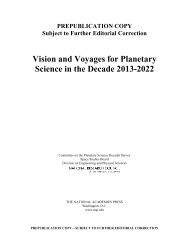Photogeologic Mapping of the Moon - Solar System Exploration
Photogeologic Mapping of the Moon - Solar System Exploration
Photogeologic Mapping of the Moon - Solar System Exploration
Create successful ePaper yourself
Turn your PDF publications into a flip-book with our unique Google optimized e-Paper software.
Part A<br />
1. Contacts are sharp; transition from plains to<br />
mountains is abrupt; hills appear as islands in<br />
smooth plains; relief <strong>of</strong> hills is variable; sinuous<br />
rilles appear to be controlled by hill<br />
topography (hills predate rilles); <strong>the</strong>re are<br />
more craters on plains than on hills.<br />
2. Smooth plains appear to be more heavily<br />
cratered than hills; explained as function <strong>of</strong> :<br />
1) areal exposure <strong>of</strong> plains emphasizes number<br />
<strong>of</strong> craters; 2) hard to preserve craters on<br />
steep slopes <strong>of</strong> hills; 3) craters difficult to see<br />
in shadows and bright hill slopes.<br />
3. Mountainous terrain pre-dates (is older than)<br />
smooth plains.<br />
4. A smooth, gently undulating surface; contains<br />
numerous sinuous rilles. One rille lies on a<br />
topographic crest and is <strong>the</strong>refore unlikely to<br />
be an erosional channel. The unit is probably<br />
volcanic in origin, emplaced in part by <strong>the</strong> sinuous<br />
rilles (lava tubes/channels).<br />
5. The hills are part <strong>of</strong> <strong>the</strong> system that surrounds<br />
Mare Imbrium and are probably related<br />
to one or more <strong>of</strong> <strong>the</strong> highly degraded and<br />
flooded multi-ring basins. Hence, <strong>the</strong>y are<br />
analogous to crater deposits around smaller<br />
structures.<br />
6. Presence <strong>of</strong> possible flow scarp. Numerous<br />
channels (rilles), some with leveed sides<br />
(Note: channel network does not interconnect<br />
and is <strong>the</strong>refore unlikely to be a fluvial<br />
ÒdrainageÓ system, analogous to terrestrial<br />
watershedsÑ<strong>the</strong> rilles are probably lava<br />
channels).<br />
Answer Key<br />
194<br />
7. Clusters <strong>of</strong> irregular, overlapping cratersÑ<br />
herringbone pattern points to south-sou<strong>the</strong>ast.<br />
All are younger than smooth plains.<br />
8. Secondary crater clusters from a large primary<br />
outside <strong>the</strong> field <strong>of</strong> view (somewhere to<br />
<strong>the</strong> south-sou<strong>the</strong>ast).<br />
9. Hummocky, irregular topography associated<br />
with inner facies; radial and concentric texture<br />
in outer facies.<br />
10. The topography is a result <strong>of</strong> ejecta from <strong>the</strong><br />
Euler impact event. The inner facies represents<br />
continuous deposits, modified by postimpact<br />
slumping; <strong>the</strong> outer facies is a result <strong>of</strong><br />
secondary cratering processes.<br />
11. NW 33 km; NE 64 km; SE 31 km; SW 23 km.<br />
Note: distances may vary somewhat, depending<br />
upon where contact is drawn.<br />
12. Presence <strong>of</strong> numerous sinuous rilles around<br />
regions <strong>of</strong> <strong>the</strong> west and south show that some<br />
Euler ejecta deposits have been covered by<br />
emplacement <strong>of</strong> late-stage mare lava.<br />
13. Parts <strong>of</strong> <strong>the</strong> smooth unit post-date Euler,<br />
o<strong>the</strong>r parts seem to have faint texture associated<br />
with outer ejecta facies <strong>of</strong> Euler and are<br />
pre-Euler.<br />
14. Crater clusters post-date Euler (are superposed<br />
on Euler ejecta), clusters post-date all<br />
mare deposits.<br />
15. The clusters are probably secondary craters<br />
from some primary crater located to <strong>the</strong><br />
south-sou<strong>the</strong>ast.<br />
Exercise Sixteen:<br />
<strong>Photogeologic</strong> <strong>Mapping</strong> <strong>of</strong> <strong>the</strong> <strong>Moon</strong><br />
Activities in Planetary Geology for <strong>the</strong> Physical and Earth Sciences EG-1998-03-109-HQ











